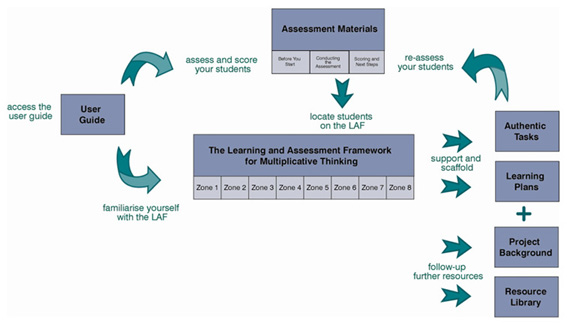On this site, teachers can find a number of connected resources that can help them to identify what their students understand and need, and then scaffold them to higher order multiplicative thinking.

These resources were developed through the Scaffolding Numeracy in the Middle Years 2003-2006 (SNMY) research project and are designed to be used with middle year’s students in Year 4 through to Year 8.
The Learning and Assessment Framework (LAF) is a key resource for teachers. It is a hierarchy of key ideas and strategies related to the development of multiplicative thinking, expressed in way that is accessible and useful to teachers.
The assessment materials are used to initially locate students against the LAF and then to assess students’ progress after targeted teaching has taken place.
Once a student is located on the LAF, teachers will be able to familiarise themselves with this zone of the framework and use learning plans, authentic tasks and other resources to help their students shift into the next zone of the LAF.
To identify where a whole class or selected students are located in relation to multiplicative thinking, the following procedure is recommended. It is important to familiarise yourself with the LAF before starting any assessment of your students.
Step 1 - Assess and score your class
There are two assessment booklets that can be downloaded from this site and used for locating students against the LAF.
Each assessment task booklet contains:
- assessment tasks
- student score sheet
- scoring rubric for each task
- raw score translator.
Before starting the assessment, you should read the instructions for preparing your students and working through an example of an assessment task with them.
It is also important familiarise yourself with the LAF before giving your students the assessment tasks.
After conducting the assessment, you then use the score sheets, scoring rubrics and the raw score translator to score and locate your students on one of the eight zones.
Read the guidelines for using the assessment materials to find out more about how to prepare, assess and score your students.
Step 2 – Consult the Learning and Assessment Framework
The Learning and Assessment Framework for Multiplicative Thinking (LAF) will provide you with the key ideas and concepts for the zone(s) where your students are located. It is linked to the assessment tasks used to evaluate multiplicative thinking and contains specific advice on teaching implications for each zone.
The LAF attempts to bring together in a hierarchy all of the key ideas, strategies and representations of multiplication and division needed to work flexibly and confidently with whole numbers, fractions, decimals and percent across a wide and expanding range of contexts.
There are eight zones in the LAF, moving from initial explorations with concrete materials through to complex multiplicative structures.
Visit the Learning and Assessment Framework section of this site to find out about:
- the development of multiplicative thinking
- the eight zones of the LAF
- teaching implications for each zone.
Step 3 – Support and scaffold your students
Once your students have been assessed and the appropriate zones have been identified, you can support and scaffold them to higher order multiplicative thinking using a range of teaching activities, tasks and other targeted interventions.
Use this site to access examples of learning plans and authentic tasks that were developed as part of the SNMY research project and are linked to the zones of the LAF.
The assessment booklets can also be used to re-assess your students after they have participated in the explicit teaching activities to evaluate their movement against the LAF. This re-assessment is recommended after a teaching period of at least six months to ensure adequate time for conceptual growth.
Step 4 – Follow up with further resources
Further professional learning resources are available in the resource library for teachers who wish to further investigate the development of multiplicative thinking. See the resource library.
The Scaffolding Numeracy in the Middle Years (SNMY) was an Australian Research Council Linkage Project awarded to RMIT University, the Victorian Department of Education and Training and the Tasmanian Education Department from July 2003 to June 2006. More information about the design, methodology and outputs of the research is available on the project background page.